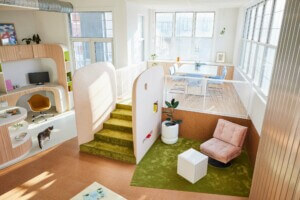The proposals are in after Monday’s final public meeting to decide the future of the Brooklyn-Queens Expressway trench which severs the Carroll Gardens, Cobble Hill, and Columbia Street Waterfront neighborhoods of Brooklyn. Residents spoke up and prioritized their wishes for a less disruptive BQE including reduced noise and pollution, increased neighborhood connectivity and bike / pedestrian safety, and an overall greener streetscape.
In short, the BQE is going green, or at least as green as a pollution-spewing six-lane highway can be. Luckily the NYC EDC, NYC DOT, and Starr Whitehouse Landscape Architects have come up with three compelling design solutions to improve the area.
Three proposed designs offer increasing levels of complexity and ambition with an eye toward construction and financial feasibility. It remains to be seen what proposed intervention will actually be implemented, but nearly any change to this urban sore can be seen as an improvement. Take a look at the three proposals below.
All three proposals build from one another, beginning with the quick fix, “Maximum Green.” This plan seeks to improve the streetscape with widened sidewalks and landscaped bumpouts and curvy chicanes. At a cost of $10.7 to $18.7 million, this should be an easy sell for even the most frugal politician. The scheme calls for shaving off unused and excessive street space on Hicks Street to calm traffic and create room for the landscaping and sidewalk.
The base model Maximum Green design keeps the existing chain-link fence surrounding the highway, but upgrades include an artsy vine-covered metal screen with built in acoustic panels (see comparison below).
Existing bridges also feature added landscaping in large planters and drastically wider sidewalks that could possibly accommodate newsstands or a proposed “BQE Flea.” Even with plants, trees, and places to sit, though, will the next hip Brooklyn hang-out be above a noxious highway?
More ambitious, the “Connections” scheme retains the basic improvements of the “Maximum Green” design and adds five new pedestrian and bike bridges across the highway and replace one existing bridge to allow handicap accessibility and help restore the original street grid.
Depending on the budget, these spans could become illuminated icons topped with photovoltaic roof panels. Options include flanking the bridges with vine-covered panels and adding LED lighting to create playful interest at night. Extra features, of course, mean inflated cost, and the Connections scheme would run between $30.1 and $41.3 million.
Finally, the “dream scheme” pulls in the massively landscaped streetscape and pedestrian bridges of the previous two proposals but does its best to mask the BQE out of the neighborhood. “Green Canopy” offers a massive $28 million steel angle-and-beam structure designed by Kiss+Cathcart Architects creating a pseudo-cap over the BQE trench. Acoustic panels built into the span mitigate noise while a central mesh of steel precludes the need for an active ventilation system.
The iconic structure is then covered in vines and solar cells which could net an estimated $312,000 in electricity annually. If all that weren’t enough, imagine dining while hovering above the highway at the “Trench Cafe.” Retail space in the Green Canopy plan is situated on the existing bridge at Union Street.
Cost to cover the highway with a giant metal mesh? $78.8 to $82.7 million. Cost to forget about the BQE forever? Priceless. Sound off on your favorite scheme in the comments below.










